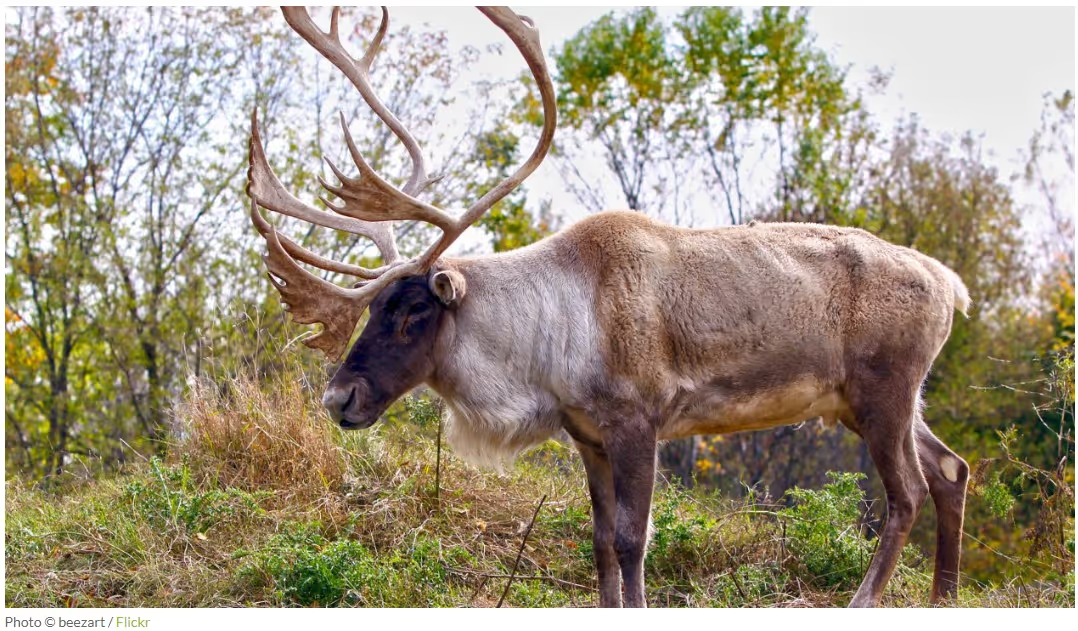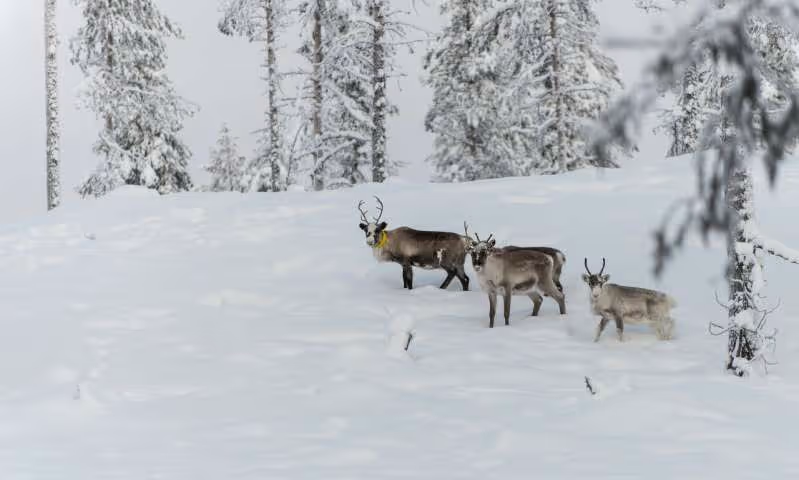Ramblin’ Reindeer, or Carousing Caribou


While watching one of the ubiquitous seasonal Christmas videos, the 1964 Animagic version of “Rudolph the Red-Nosed Reindeer” (grown-up kids still enjoy the Christmas stories and yes, it is on a VHS tape…) I noticed (not for the first time) that the female reindeer were depicted without antlers. I knew this was a falsehood, but once again I didn’t spoil it for the kids, however grown up they may be. Today I received in my inbox the Cool Green Science newsletter and found that my favorite blogger, Matthew Miller, had written an article containing this and some other fascinating facts about reindeer. I hope he will forgive me for passing them on; he deserves credit for the research and inspiration.

First, regarding antlers. Both male and female reindeer have antlers. Both sexes shed their antlers annually, but the males proceed with that after the breeding season, so likely won’t have any antlers at Christmas time. The females keep their antlers through the winter, dropping them around calving time in the spring. What does that say about Santa’s sleigh-pulling team? Ladies? I’m happy to note that in the Netflix Christmas Chronicles movies, the members of the sleigh team were referred to with the female pronoun.
Secondly, what about “reindeer” versus “caribou?” Both refer to the same species of ungulate, Rangifer tarandus. In Europe and Asia, the animals have been herded and domesticated for centuries, even though they still roam and sometimes even migrate under the care of their herders. These are called “reindeer,” and they have become stockier in build and have shorter legs than their wild counterparts in North America, which we call “caribou.”
Reindeer hooves do click, just like in the song, but not because they are hard against pavement and rooftops. After all, those are all covered in snow, right? They click because there are tendons that slide over the bones in their feet, making a loud clicking sound. Matthew says “Many sources hypothesize that this click allows reindeer to hear each other in harsh or foggy weather, thus enabling herds to stick together. Recent research has shown that the bigger the reindeer, the louder the click. A loud click may enforce social hierarchy or even help attract potential mates.”
Now for the nose. Rudolph’s red nose wouldn’t be necessary for sight guiding, because reindeer are one of the few mammals that can see ultraviolet light. This is possible because their eyes change, seasonally, from a summer golden to a winter blue, which gives them a higher degree of visual sensitivity in the dark northern winters. Nose-wise, however, a real reindeer’s nose viewed with thermal cameras does have a reddish tinge to it. This is because its nose is full of blood vessels. Another adaptation for living in really, REALLY cold places, the reindeer nose acts like a heat exchanger. When the reindeer breathes in, all the blood vessels in its nose serve to warm the air before it enters the lungs. And when the animal breathes out, the air coming out of the lungs is cooled down tremendously, saving that heat inside their body instead of expelling steam into the air.
Finally, let’s look at what they eat. Maybe it’s been part of your tradition to leave carrots for the reindeer when you leave cookies for Santa, many people across the globe do. If the reindeer were polite enough to eat said carrots, they probably got a tummy-ache on the way home, because reindeer teeth aren’t made for chewing up something as tough and hard as a carrot. They prefer the lichens that grow on the tundra, the occasional lemming (if you believe the online stories), and the hallucinogenic fly agaric mushroom. Yes, indeed, look here at an article from Drug Discovery Today if you don’t believe…. So now we know how they fly! http://www.drugdiscoverytoday.com/view/14778/why-reindeer-love-magic-mushrooms/
The Rudolph story was a poem written by Robert May in 1939, an assignment by his employer, the Montgomery Ward department store, and was turned into a song by Johnny Marks when the film was created. But reindeer, even flying reindeer, have been a part of human legends since ancient times, as reflected by carvings found all over the world (but concentrated in Siberia and Mongolia). These carvings, with the reindeer legs stretched out in front and back, lead to resolution of another of my mental puzzles – why do Santa’s reindeer need to “gallop” through the air instead of sprouting wings or just soaring along? The surprisingly strong and fast swimming ability of real reindeer may be another clue.

Of course, I regret to say, we can’t have an article about wildlife without mentioning how the Earth is becoming less hospitable to many species. Reindeer may be one of the animals most affected by climate change. While they have adapted to thrive in the cold, their bodies do not dissipate heat well, and they travel with less injury over ground that is deep with snow. The last caribou herd remaining in the U.S. lower 48 has moved north to join a herd in Canada. Five of the Alaska-Canada herds’ numbers are down to 10% of what they were 25 years ago, and overall the wild population of caribou is down 40% in that same time frame. In December 2019, USA Today reported that hundreds of thousands of Scandinavian reindeer face starvation due to changing conditions. So please, do your due diligence in every way you can to help mitigate the changes our Earth faces. At the same time, celebrate how amazing is this world and ALL of its inhabitants.
© Virginia Molenaar, December 2020
Touch whale bones, examine shipwreck artifacts and connect with the coast's living history.

Support our mission, get involved in educational programs, or contribute through donations and volunteering.